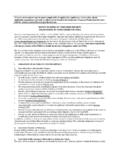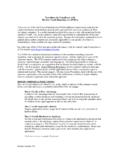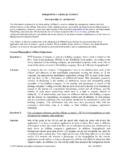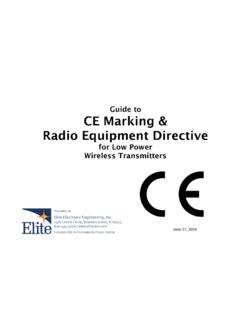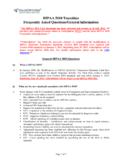Transcription of Understanding and Eliminating EMI in …
1 COP888 Understanding and Eliminating EMI in Microcontroller ApplicationsLiterature Number: SNOA382TL/DD12857 Understanding and Eliminating EMI in Microcontroller ApplicationsAN-1050 National SemiconductorApplication Note 1050 Robin GetzBob MoeckelAugust 1996 Understanding andEliminating EMI ABSTRACTIn today s world, with increasing numbers of both fixed andmobile electronic devices, electromagnetic compatibility(EMC) is becoming a critical issue. Disastrous, if not annoy-ing, results occur if a system, subsystem or component in-terferes with another through electromagnetic means. TheEMC problem is first explained, and then the basic theory ispresented with an explanation on how to use it to control anEMC problem during the initial design phase.
2 The methodsthat some silicon manufacturers are using to control EMCand how these changes affect our systems will be exam-ined. A total system (automobile radio) will be examined indetail to prove the effectiveness of a EMC reduced COP8TM(8-bit microcontroller). Overall design guidelines will also begiven so that the designer can minimize EMIbefore it be-comes a INTRODUCTION AND BACKGROUNDE lectromagnetic Interference with PoweredWheelchairsAugust 26, 1994 FDA is receiving inquiries about reports that electromagnet-ic interference (EMI) can cause some power-driven wheel-chairs and scooters to move unexpectedly. The agency hasinvestigated this matter and determined that EMI can causeunexpected movement in some power-driven wheelchairswhen they are turned on.
3 Not all brands and models of pow-er wheelchairs and scooters have this problem. Some havegreater immunity levels than others that may protect againstEMI. Common sources of EMI include cellular phones, CBradios, TV and radio stations, amateur (HAM) radios andpolice, fire and ambulance receiving reports of problems, FDA tested samplewheelchairs and scooters in its laboratories and obtainedinformation from manufacturers and users about possibleEMI-related incidents. As a result of its review, the agencylast May asked wheelchair manufacturers to take steps toprotect powered wheelchair users from the potential haz-ards of EMI.
4 FDA required all firms to clearly label wheel-chairs and scooters with the immunity level, or else statethat the immunity level is not known. It also required them tolabel wheelchairs and scooters to warn users of the poten-tial hazards of EMI. The agency also asked manufacturersto:1. Establish a minimum recommended immunity level of20V per meter for all new motorized wheelchairs andscooters. This would provide a reasonable degree of pro-tection against the more common sources of Undertake an educational campaign to inform users andthose who care for them about the risks of EMI and waysto avoid it; and3. Solicit reports of possible EMI incidents and continue tomonitor the full scope of the first learned of a possible problem with motorizedwheelchairs from a complaint in June 1992.
5 As a result, theagency began testing sample wheelchairs in its tests, on several brands of power-driven wheelchairsand scooters, revealed that most but not all of thosesampled were susceptible to interference at various radiofrequencies. In some tests, the brakes released. In others,the wheels moved uncontrollably. Sometimes both occurredat once. The extent to which this happens in actual use isnot known. In early 1993, FDA began inspecting facilities ofall domestic and foreign motorized wheelchair and scootermanufacturers to gather information on the problem. Theagency reviewed warranty and complaint files and looked atany manufacturing practices that could contribute to thistype of problem.
6 The inspections revealed numerous com-plaints about erratic, unintentional wheelchair movement,sometimes resulting in injuries. It is unclear, however, exact-ly what caused the chairs to move in those cases. In addi-tion to EMI, unexpected movement can be caused by failureof an electronic component or by user May 1993, FDA sent letters to all manufacturers ask-ing them to provide any information they had about possibleproblems with radio wave interference, including com-plaints, reports of injuries and studies on power-drivenwheelchairs. In July 1993, the agency alerted consumergroups that represent wheelchair users about the possibleproblem and requested similar information.
7 An estimated10,000 motorized wheelchairs and 50,000 motorized scoot-ers are sold annually in this country. FDA Report, August 1994 The control and minimization of EMC is a technology that is,out of necessity, growing rapidly. Manufacturers and regula-tory agencies have made efforts to control this problem butthe issue of meeting these ever tightening specifications isleft to the system designer. EMC can no longer be a fix,designed in at the last moment, but must be a directed effortbetween the circuit designer, layout engineer, software engi-neer and purchaser. This paper will examine what can bedone to reduce the chance of having a product fail a trademark of National Semiconductor National Semiconductor CorporationRRD-B30M106/Printed in U.
8 S. The EMC World MapBefore jumping into the midst of the EMC design methodsused, it is best to gain an Understanding of the problemsituation and review or learn applicable electromagnetic(EM) theory. To begin, look at what I call the map of theEMC world, Table I. The EMC problem is between an emis-sion culprit and susceptible victim which are coupledthrough a means, either radiation through space or conduct-ed through wires(Figure 1). We can map out the EMC prob-lem cases with columns headed by radiation and conduc-tion, and rows headed by emission and susceptibility, to getfour cases abbreviated as RE, CE, RS, I. ElectroMagnetic Compatibility What Designers Do Upon A Discovery of an EMCP roblemTypically, the first time system designers realize that theyhave a RE problem is after the prototype system has beenbuilt and evaluated.
9 Instead of being close to market re-lease they now find themselves applying costly and oftenineffective patches and going back into redesign. The stepsoutlined in Table II are what a typical person does at thispoint. First reaction is to make the printed circuit board(PCB) trace length short or to upgrade to a higher cost PCBwith a full ground plane. Although most system companieshave experienced and good layout design rules for theirPCBs, enforcing these rules is sometimes difficult to do asmore and more components are being packed into smallerpackages on a smaller board. Layout is often subcontractedand the designer may not have the necessary experienceand motivation, cost reduction is the goal.
10 Next, filters (RC,RL, or ferrite beads) are added in hopes that this may fix theproblem. Also, the crystal frequency may be reduced byabout 2x to run the system clock at a slower rate. Softwaremay have to be rewritten to compensate for this new timebase. Software can be redone to toggle the outputs lessfrequently. Shielding is added or the PCB is put into an elec-trically out of the way place (like hiding a monster in thebasement). Having exhausted their design tricks, the de-signers now search other semiconductor suppliers to find aquieter part. Finally, when all the time and money runs outwith EMC qualification failing, the decision is made not tomarket the product and everyone loses is from this examination that we can understand that EMCdesign issues have to be considered properly at the begin-ning of the design cycle, in order to reduce complex designchanges which must be done at the completion of the proj-ect if EMC testing is II.










